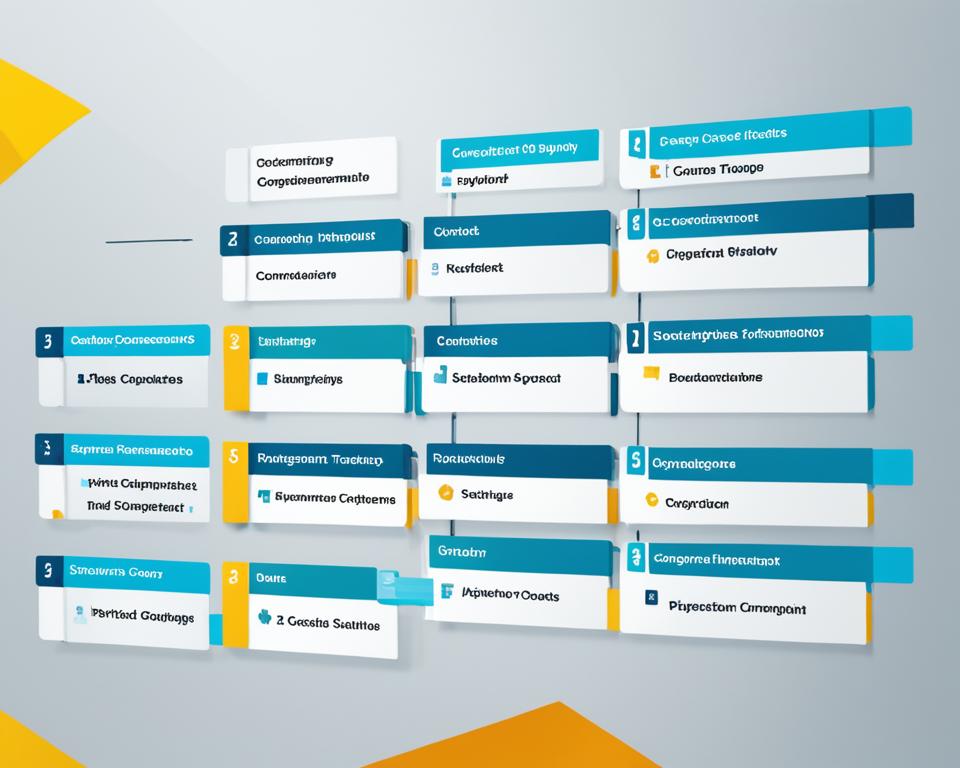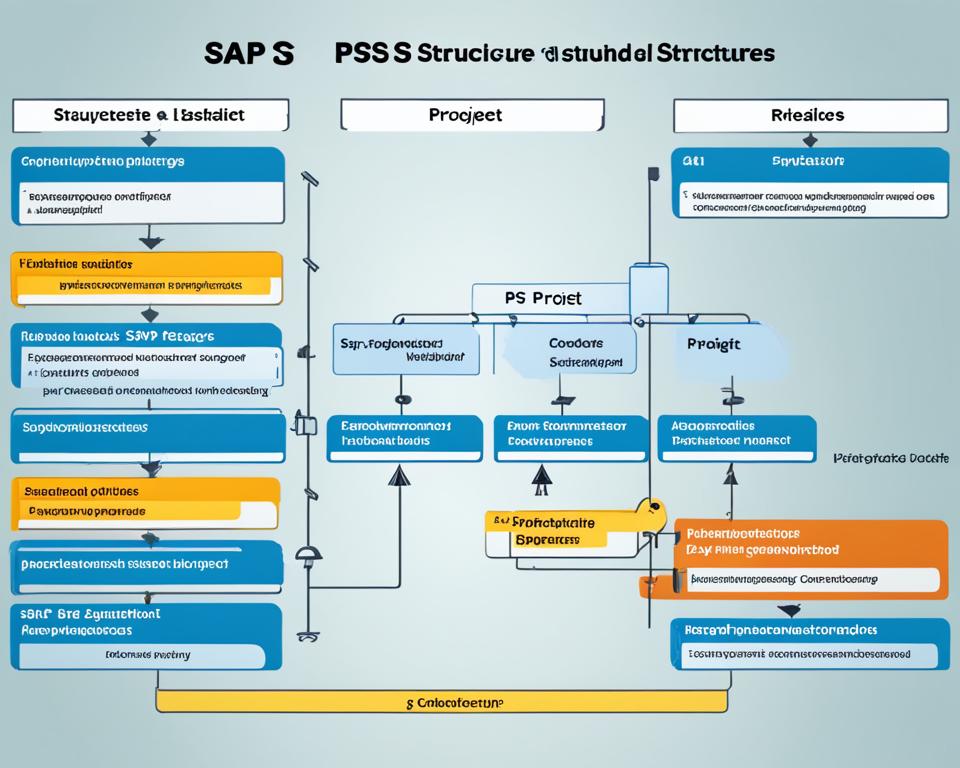Have you ever wondered why some companies handle complex projects smoothly while others face challenges? The secret often lies in tools like SAP PS (Project Systems). It’s a key part of the SAP ERP suite for managing projects well. With SAP PS, companies can make projects more visible, simplify processes, and increase efficiency. This leads to projects finishing successfully.
In today’s fast-paced world, having a clear plan for managing projects is crucial. SAP PS shows how teams can plan, carry out, and keep an eye on their projects in various sectors. It changes how they manage their projects.
Key Takeaways
- SAP PS makes managing projects more efficient.
- Streamlined processes help projects finish well.
- Improves project visibility for teams.
- Supports effective planning and execution of projects.
- Helps with better resource allocation for projects.
Understanding the Basics of SAP PS
To get the most out of SAP PS, it’s key to understand its core ideas. The SAP PS basics focus on managing projects well. They work smoothly with other SAP parts. This includes planning projects, assigning resources, and tracking costs.
Learning about these key points helps me use SAP PS better in my projects. An introduction to SAP PS shows how it helps organize projects and track progress. It also makes sure resources are used well. Knowing these basics helps people and companies get better results from their projects.
Mastering SAP PS makes projects clearer from start to finish. It helps with making smart choices and building better relationships with suppliers. For those looking to improve procurement, seeing how Ariba works with SAP can be very useful. As I learn more, I see the big advantages of understanding SAP PS well.
| Concept | Description |
|---|---|
| Project Planning | Involves defining objectives and determining tasks and schedules. |
| Resource Allocation | Ensures optimal use of personnel and materials throughout a project. |
| Cost Analysis | Focuses on estimating and controlling project expenses. |
Key Features of SAP PS
SAP PS features offer a strong framework for managing projects well. It covers important areas like planning, managing resources, and controlling costs. Knowing these features can greatly improve project success and make processes smoother in companies.
Comprehensive Project Planning
Good project planning is key to hitting deadlines and keeping to budgets. SAP PS has advanced tools for planning, scheduling tasks, and tracking milestones. Users can make detailed project plans that keep every phase well-organized and carried out well. This kind of planning is a big factor in project success.
Resource Management Capabilities
Effective resource management is crucial for project success. With SAP PS, I can manage all resources like people, equipment, and materials. This lets companies work more efficiently and make sure the right resources are used at the right time. For more tips on improving resource management, check out mastering ABAP reports.
Cost Control Mechanisms
Keeping costs under control is essential for a project’s success. SAP PS helps businesses keep a close eye on costs, sticking to budgets and quickly fixing any issues. This feature gives a clear view of expenses, helping with better decisions and improving financial health.

| Feature | Description | Benefits |
|---|---|---|
| Comprehensive Project Planning | Tools for scheduling, task allocation, and milestone tracking. | Ensures organized project phases and meets deadlines. |
| Resource Management | Management of personnel, equipment, and materials. | Maximizes efficiency by optimizing resource utilization. |
| Cost Control Mechanisms | Rigorous cost monitoring methods. | Maintains budget adherence and provides financial transparency. |
The Importance of Project Planning
Project management relies heavily on effective project planning. In SAP PS project planning, this means making projects run smoother. By planning well, I set clear goals, deadlines, and who does what. This makes hitting project targets on time and within budget more likely.
Good planning helps spot risks early. By tackling these issues early, I can adjust the project and get the right people on board. This way, problems don’t get worse and management stays strong from start to finish.
- Risk Management: Planning well helps spot risks early, so we can act fast.
- Resource Alignment: Matching resources with goals means we can tackle tasks quickly.
- Scope Definition: A clear scope stops projects from getting too big, keeping timelines and budgets under control.
Using SAP PS project planning makes each project phase run better. It helps my team work together smoothly. Knowing how crucial mastering project planning is in SAP PS leads to strong, efficient results.
| Project Aspect | Impact of Planning |
|---|---|
| Risk Identification | Prevents delays and cost overruns |
| Resource Allocation | Enhances productivity and efficiency |
| Timeline Management | Improves adherence to schedules |
Integrating SAP PS with Other Modules
SAP PS works best when it’s linked with SAP Finance (FI), Controlling (CO), and Material Management (MM). This connection makes sure data moves smoothly across the company. It boosts how well projects are managed.
By connecting SAP PS with these modules, I can watch project performance closely. This helps keep finances and materials in line. It’s a big win for managing projects well.
One key advantage of SAP PS integration is its cross-module functionalities. It links project systems with finance modules for better cost tracking. It also connects with material management to keep inventory levels right. This makes sure projects have what they need.
The table below shows how SAP PS and other modules help with project management:
| Integration Aspect | SAP Module | Benefit |
|---|---|---|
| Cost Tracking | Finance (FI) | Enables real-time visibility of project costs and budget adherence. |
| Performance Analysis | Controlling (CO) | Facilitates comprehensive assessment of project profitability and efficiency. |
| Resource Planning | Material Management (MM) | Optimizes inventory management to ensure resource availability for projects. |
Knowing how SAP PS works with other SAP modules makes project monitoring better. It also helps with making quick decisions. Adding SAP PS integration to daily work can greatly improve project results and efficiency.
Exploring Project Lifecycle Management in SAP PS
Project lifecycle management is key to using SAP PS well. It guides projects from start to finish, making sure each stage is covered. Knowing the SAP PS lifecycle phases helps keep projects on track with company goals and leads to success.
Phases of the Project Lifecycle
The SAP PS framework includes a full set of lifecycle phases:
- Initiation: Setting project goals and defining what needs to be done.
- Planning: Making detailed plans for resources, timelines, and budgets.
- Execution: Putting the project plan into action and managing the team.
- Monitoring: Keeping an eye on progress and making sure it matches the plan.
- Closure: Wrapping up all project tasks and checking if they met expectations.
Each phase is vital for project success, showing why structured management is crucial.
Integral Components of Lifecycle Management
In SAP PS, key components help manage the lifecycle well:
- Project Structures: These frameworks show how different parts of a project connect.
- Budgeting: Planning and using money wisely, and allocating resources.
- Scheduling: Making timelines to manage project tasks.
- Risk Management: Finding and reducing risks during the project.
By focusing on these areas, companies can keep a close eye on their projects and improve their results. Using tools like Ariba Supplier Collaboration can also help with supply chain work, which is key for managing project phases.
Setting Up Project Structures in SAP PS
Setting up project structures setup in SAP PS is key for managing resources and tasks well. A clear project hierarchy acts as a guide for the team through each phase. Using SAP PS structures like Work Breakdown Structures (WBS) helps me divide big projects into smaller parts.
A structured approach makes it easier to see project parts. This makes managing and tracking the project smoother. Let’s dive into how to set up these important parts:
- Define Project Objectives: Clearly state what I want to achieve, making sure all parts of the project fit these goals.
- Create Work Breakdown Structures: Divide the project into smaller tasks and subtasks for better organization.
- Establish Networks: Find out which tasks depend on each other, showing the order they should be done in.
- Assign Resources: Put the right resources on each task, making sure each one has what it needs.
By focusing on my project hierarchy and using strong SAP PS structures, I get a full view of my project’s progress and issues. This detailed project structures setup improves project management and encourages team accountability.

Effective Financial Tracking within SAP PS
Keeping an eye on project costs is key in SAP PS. It helps make sure spending matches up with the company’s goals. I can check detailed reports on spending and budgets. This gives me the info I need to make smart choices.
SAP PS financial management shines with its real-time data. This lets me watch the finances closely. If costs look like they’ll go over budget, I can make quick changes. This is crucial for keeping project costs under control.
Here are some top features of financial tracking in SAP PS:
- Real-time expense monitoring
- Integrated financial reporting
- Budget variance analysis
- Forecasting tools for future financial planning
With these features, I can track finances better, leading to better project results. An efficient system for tracking finances does more than just keep the budget healthy. It also builds trust and openness in every project phase.
| Financial Tracking Features | Benefits |
|---|---|
| Real-time Monitoring | Immediate insights into financial performance |
| Integrated Reports | Comprehensive view of project financials |
| Variance Analysis | Early identification of budget issues |
| Forecasting Tools | Better preparation for future expenses |
Utilizing SAP PS for Project Portfolio Management
Using SAP PS in project portfolio management has big benefits for companies managing many projects. It helps me keep track of priorities and align them with our business goals. This makes it easier to see what’s going on in each project and how to use resources well.
SAP PS lets me check how all active projects are doing and make choices based on data. This helps balance out the demands of different projects. By looking at project status, timelines, and how resources are used, I can spot where we need to focus and move resources around.
- Strengthened alignment: Connects projects to organizational goals for focused outcomes.
- Improved decision-making: Facilitates informed decisions based on comprehensive data.
- Enhanced resource efficiency: Optimizes how resources are allocated across the project landscape.
By using SAP PS’s features well, I get a big strategic edge over other projects. This leads my organization to do better and achieve more success. Good project portfolio management means we can predict project results and do better overall.

Maximizing Resource Allocation in Projects
Effective resource allocation is key to project success. By placing the right resources at the right time, project outcomes get better. In SAP PS, tracking resources’ skills and availability is vital. This leads to better project management and faster goal completion.
Importance of Resource Allocation
Resource allocation is crucial for project efficiency. I make sure to know my resources’ skills and when they’re available. This lets me use them wisely, especially in project critical phases. Good allocation means less downtime and more work done.
Strategies for Effective Allocation
Using smart strategies can greatly improve project results. I use several methods, including:
- Cross-training employees for more skills.
- Planning for resource needs based on project timelines.
- Using SAP PS analytics to adjust allocations on the fly.
These strategies help match my team’s skills with project needs. It boosts efficiency and makes projects more resilient.
Cost Control Techniques in SAP PS
Keeping costs under control in SAP PS is key to a project’s financial health. Using cost control techniques helps keep projects on budget and meet goals. These include careful budgeting, forecasting, and analyzing variances.
Setting financial goals and tracking them through SAP PS helps managers catch cost issues early. Here are key parts of good cost management:
- Budget Planning: Making detailed budgets for all project costs sets clear financial goals.
- Forecasting: Updating financial forecasts helps predict and avoid spending too much.
- Variance Analysis: This method finds and fixes differences between planned and actual costs.
These techniques in SAP PS give managers the insights they need to make smart choices. Knowing about ABAP Object-Oriented Programming boosts their analytical skills in cost management. This knowledge leads to better project outcomes and resource use, making it a key tool for SAP PS cost management. For more on ABAP OOP, click here.

| Technique | Description | Benefits |
|---|---|---|
| Budget Planning | Establish a detailed budget for project expenses | Ensures financial discipline and accountability |
| Forecasting | Update financial forecasts regularly to reflect current spending | Identifies potential over-expenditures early |
| Variance Analysis | Analyze discrepancies between budgeted and actual costs | Facilitates timely corrective actions |
Enhancing Project Reporting with SAP PS
Effective project reporting is key to keeping track of performance and hitting goals. SAP PS offers powerful tools for deep insights into project performance. These tools make project reporting better, helping to analyze budget use, performance, and how resources are used.
Types of Reports Available
SAP PS has many reports for different project needs. Knowing what reports are available helps managers check on projects better. Here are some common reports:
- Budget Reports: Check how well the budget is being followed during the project.
- Performance Metrics Reports: Look at key performance indicators to see if the project is a success.
- Resource Utilization Reports: See how well resources are being used.
- Time Tracking Reports: Keep an eye on project timelines and milestones.
- Risk Assessment Reports: Spot and look into risks that could affect the project.
Utilizing Reports for Decision Making
Using SAP PS reporting features is crucial for making good decisions. These reports help managers make informed choices by showing the project’s status clearly. With real-time data, managers can adjust plans to meet goals. Here’s how reports help in decision making:
- Spotting problems early through ongoing checks.
- Improving how resources are used based on what the data shows.
- Changing timelines and budgets as the project changes.
- Giving detailed data to stakeholders for clear communication.
Best Practices for SAP PS Implementation
Starting a SAP PS project needs a careful plan and getting ready. I make sure to talk to all the people who will be involved early. This way, their thoughts and needs help guide the project. It’s a key way to make sure everyone feels part of the project and makes the change smoother.
It’s also important to keep training the team. By doing this, we make sure they know how to use SAP PS well. This helps the project run smoothly and tackles any problems that come up.
Good communication is key during the project. It keeps everyone talking and makes sure they know what’s going on. I focus on being clear with everyone to avoid any confusion or disagreements.

In short, here are the main tips for doing SAP PS implementation well:
| Best Practice | Description |
|---|---|
| Planning and Preparation | Good planning is the first step to success. |
| Stakeholder Engagement | Talking to stakeholders helps get their support. |
| Continuous Training | Training keeps the team ready for their tasks. |
| Clear Communication | Being clear helps avoid any confusion. |
Challenges and Solutions in SAP PS
SAP PS can be complex, making it hard for users to learn. This can slow down project management. During implementation, companies often face problems that slow them down if not fixed quickly.
To solve these issues, training programs are key. They help team members learn how to use the system better. This makes them more confident in their work.
Managing changes is also crucial. It’s important that everyone understands the system’s benefits. Getting feedback from users helps make the system better. This way, teams can fix problems early on.
- Implement comprehensive training programs for new users.
- Establish clear communication channels during the transition.
- Utilize feedback mechanisms to refine processes continually.
By focusing on these areas, companies can better handle SAP PS challenges. Overcoming these hurdles leads to more efficiency and success in projects. This sets a strong base for future projects.
Future Trends in Project Management with SAP PS
The world of project management is changing fast. I’m looking into SAP PS future trends and see big changes coming. Technologies like artificial intelligence and machine learning will soon be part of SAP PS. These will make predicting project outcomes better, helping managers make smarter decisions.
Companies need to keep up with project management innovations to stay ahead. Using real-time data and automation will help managers spot problems and chances early. This makes work flow better and helps use resources well, so projects can be done right.
Also, tools like SAP Ariba will work better with SAP PS. They help improve how we buy things and manage projects. This gives businesses a full view of project management, making working with suppliers better and making things more efficient.
Conclusion
This article shows how SAP PS is key for managing projects well. It has strong features for planning projects, managing resources, and tracking finances. These tools help organizations improve their project results and succeed.
SAP PS is crucial for today’s fast-paced business world. It gives teams an edge by making processes smoother and improving teamwork. Using SAP PS, project managers can tackle challenges better and make decisions based on data for better outcomes.
Using SAP PS boosts project performance and helps the whole organization work better. I plan to keep exploring SAP PS’s potential. This will help me manage my projects with the accuracy and insight needed to succeed in a changing world.



Leave a Reply